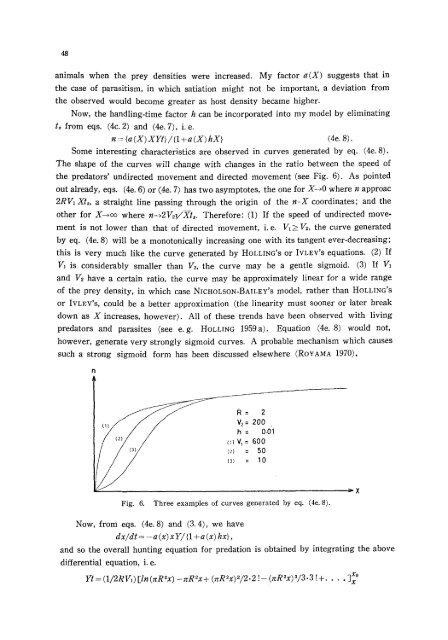A comparative study of models for predation and parasitism
A comparative study of models for predation and parasitism
A comparative study of models for predation and parasitism
Create successful ePaper yourself
Turn your PDF publications into a flip-book with our unique Google optimized e-Paper software.
48<br />
animals when the prey densities were increased. My factor a(X) suggests that in<br />
the case <strong>of</strong> <strong>parasitism</strong>, in which satiation might not be important, a deviation from<br />
the observed would become greater as host density became higher.<br />
Now, the h<strong>and</strong>ling-time factor h can be incorporated into my model by eliminating<br />
t~ from eqs. (4c. 2) <strong>and</strong> (4e. 7), i.e.<br />
n = {a (X) XYt}/{1 + a (X) hX} (4e. 8).<br />
Some interesting characteristics are observed in curves generated by eq. (4e. 8).<br />
The shape <strong>of</strong> the curves will change with changes in the ratio between the speed <strong>of</strong><br />
the predators' undirected movement <strong>and</strong> directed movement (see Fig. 6). As pointed<br />
out already, eqs. (4e. 6) or (4e. 7) has two asymptotes, the one <strong>for</strong> X-~0 where n approac<br />
2RVI Xt,, a straight line passing through the origin <strong>of</strong> the n-X coordinates; <strong>and</strong> the<br />
other <strong>for</strong> X~oo where n-~2V~v'Xt,. There<strong>for</strong>e: (1) If the speed <strong>of</strong> undirected movement<br />
is not lower than that <strong>of</strong> directed movement, i.e. V~ > V~, the curve generated<br />
by eq. (4e. 8) will be a monotonically increasing one with its tangent ever-decreasing;<br />
this is very much like the curve generated by HOLLING'S or IVLEV'S equations. (2) If<br />
Va is considerably smaller than V2, the curve may be a gentle sigmoid. (3) If V1<br />
<strong>and</strong> V~ have a certain ratio, the curve may be approximately linear <strong>for</strong> a wide range<br />
<strong>of</strong> the prey density, in which case NICHOLSON-BAILEY'S model, rather than HOLLING'S<br />
or IVLEV's, could be a better approximation (the Iinearity must sooner or later break<br />
down as X increases, however). All <strong>of</strong> these trends have been observed with living<br />
predators <strong>and</strong> parasites (see e.g. HOLLING 1959a). Equation (4e. 8) would not,<br />
however, generate very strongly sigmoid curves. A probable mechanism which causes<br />
such a strong sigmoid <strong>for</strong>m has been discussed elsewhere (RoYAMA 1970).<br />
R= 2<br />
v2-- 200<br />
h = 0.0'1<br />
(~) V~ = 600<br />
{2) = 50<br />
{3) = 1 0<br />
Fig. 6. Three examples <strong>of</strong> curves generated by eq. (4e. 8).<br />
:~X<br />
Now, from eqs. (4e. 8) <strong>and</strong> (3. 4), we have<br />
dx/dt = -a (x) xY/ {1 +a (x) hx} ,<br />
<strong>and</strong> so the overall hunting equation <strong>for</strong> <strong>predation</strong> is obtained by integrating the above<br />
differential equation, i.e.<br />
Yt = (1/2R V1) [ln (nR 2x) - nR 2x + (nR 2x) 2/2.21 - (nR ~x) 3/3.3 ! + ....<br />
]xo















